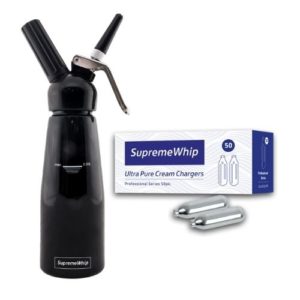Introduction
In a world significantly aware of ecological concerns, every item we utilize comes under scrutiny. One such item gaining attention is Pure N2O Cream Chargers These little cylinders, frequently discovered in kitchen areas and coffee shops, are mainly used for light whipping cream however are likewise connected with a range of ecological ramifications. This post digs deep into comprehending these impacts, exploring their chemical properties, usage patterns, and potential effects on our planet.
Understanding the Ecological Impact of Pure N2O Cream Chargers
The main active ingredient in cream charger whips is nitrous oxide (N2O), typically described as laughing gas. While its main function is genuine-- whipping cream and creating wonderful cooking experiences-- its environmental implications are less celebrated.
What Are Pure N2O Cream Chargers?
Pure N2O cream chargers are small metal canisters filled with nitrous oxide. They are designed to be inserted into a whipped cream dispenser, permitting users to create light and fluffy whipped toppings quickly. The gas is launched when the charger is punctured, broadening and whipping the cream within the dispenser.

Chemical Characteristics of Nitrous Oxide
Nitrous oxide has special chemical homes that make it effective in culinary applications. Unlike other gases, it remains steady at room temperature level and pressure. However, its contributions to greenhouse gases raise substantial concerns:
- Global Warming Possible (GWP): N2O has a GWP of 298 times that of co2 over a 100-year period. Stratospheric Ozone Depletion: Nitrous oxide contributes in ozone depletion, affecting natural ecosystems.
The Life process of Cream Chargers
To understand their environmental impact totally, it's vital to analyze the life process of cream chargers:
Production: The manufacturing process involves extracting laughing gas from gas or through chemical reactions. Distribution: Carrying these battery chargers adds to carbon emissions. Usage: While utilizing them for culinary purposes seems harmless, their release into the environment contributes to greenhouse gas levels. Disposal: Improper disposal can cause pollution and waste management challenges.The Function of Laughing gas in Climate Change
How Does Laughing gas Contribute to Global Warming?
Nitrous oxide is among the substantial factors to environment modification due to its high GWP. When launched into the atmosphere through different sources-- consisting of farming practices and commercial procedures-- it contributes considerably to worldwide warming.
Key Factors:
- Agricultural fertilizers Transportation Industrial activities
Comparative Analysis: N2O vs Other Greenhouse Gases
|Greenhouse Gas|International Warming Potential|Lifetime in Atmosphere|| -----------------|-------------------------|------------------------|| CO2|1|100 years|| CH4 (Methane)|25|12 years|| N2O|298|114 years|

This table highlights why even small amounts of nitrous oxide can have significant impacts on climate change.
Environmental Regulations Surrounding Cream Chargers
Legislation Overview
Various countries have begun executing policies regarding the production and use of laughing gas due to its ecological impact. In some areas, there are stringent controls on where and how these chargers can be sold or gotten rid of of.
Notable Laws:
- European Union regulations on greenhouse gases Local restrictions on unneeded usage in restaurants
Industry Compliance Measures
Many producers are taking actions to abide by these guidelines by:
- Developing more eco-friendly production methods Encouraging correct disposal techniques Offering recycling programs for utilized canisters
Sustainable Alternatives: Exist Much better Options?
Exploring Eco-Friendly Whipping Agents
As society becomes more eco-conscious, alternatives to conventional pure N2O cream chargers are emerging:
Air-Powered Whippers: These gadgets utilize air rather of nitrous oxide. Plant-Based Whipping Agents: Derived from natural sources that may use comparable textures without damaging the environment.Consumer Preferences Shift Towards Sustainability
Consumers are significantly looking for items that line up with their values relating to sustainability, leading many brands to innovate responsibly.
Best Practices for Using Cream Charger Whips Responsibly
Proper Use Guidelines
To reduce ecological effect while using cream chargers:

Educating Consumers About Responsible Use
Raising awareness about how customers can reduce their impact while delighting in whipped deals with is crucial for sustainable practices moving forward.
FAQ Section
Q1: What are cream charger whips made from?
Cream charger whips are usually made from metal canisters filled with pure nitrous oxide (N2O).
Q2: Is using pure N2O harmful?
While utilizing pure N2O safely for light whipping cream postures minimal threat when managed properly, https://nitrouswhip.com.au/ incorrect disposal or extreme inhalation can have adverse health impacts and add to environmental issues.
Q3: Can I recycle my utilized cream chargers?
Yes! Numerous places provide recycling programs for utilized cream battery chargers; check local standards for specific procedures.
Q4: Exist any eco-friendly options available?
Yes! Air-powered whippers and plant-based whipping representatives serve as alternative choices that minimize reliance on nitrous oxide.
Q5: What must I do if I have leftover unused chargers?
Store them securely according to manufacturer instructions until you can use them or find a suitable recycling program near you.
Q6: How does nitrous oxide affect environment modification compared to other gases?
Nitrous oxide has a far greater worldwide warming capacity than carbon dioxide or methane regardless of existing in smaller amounts in the atmosphere.
Conclusion
Understanding the ecological effect of pure N2O cream chargers is necessary as we browse our cumulative obligation towards sustainability. While these convenient tools provide culinary benefits, they likewise bring considerable implications for our environment due to their contribution to greenhouse gases like laughing gas. By adopting accountable practices-- whether through correct use or thinking about sustainable alternatives-- we can enjoy scrumptious whipped developments while minimizing our eco-friendly footprint.
Ultimately, raising awareness about these issues allows consumers and producers alike to interact towards more sustainable options that benefit both our tastes buds and our world-- a sweet balance all of us deserve!